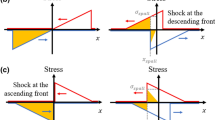Abstract
The pressure-shear plate impact experiment has been modified to test materials at high temperatures (up to 700°C). Together with the high strain rates characteristic of this experiment (106 s−1), the high-temperature capability allows the shearing resistance of materials to be measured under conditions unattainable with other testing equipment. The compressive and shear responses of pure tungsten carbide at different temperatures are presented, as well as the results of one test on OFHC copper at a temperature of 691°C and a shear strain rate of 1.4×106 s−1.
Similar content being viewed by others
References
Marchand, A. andDuffy, J., “An Experimental Study of the Formation Process of Adiabatic Shear Bands in a Structural Steel,”J. Mech. Phys. Solids,36 (3),251–283 (1988).
Zhou, M., Rosakis, A.J., andRavichandran, G., “Dynamically Propagating Shear Bands in Impact-loaded Prenotched Plates—I. Experimental Investigations of Temperature Signatures and Propagation Speed,”J. Mech. Phys. Solids,44 (6),981–1006 (1996).
Giovanola, J., Proceedings on Impact Loading and Dynamic Behavior of Materials, Bremen, Federal Republic of Germany (1987).
Clifton, R.J. andKlopp, R.W., “Pressure-shear Plate Impact Testing,”Metals Handbook: Mechanical Testing, American Society for Metals, 9th ed., Metals Park, OH, Vol. 8, 230–239 (1985).
Smithells, C.J. andBrandes, E.A., Metals Reference Book, 5th ed., Butterworth, Boston, 953–975 (1976).
Storms, E.K., Refractory Metals, Academic Press, New York, 152 (1967).
Exner, H.E., “Physical and Chemical Nature of Cemented Carbides,”Int. Metals Rev., (4),149–173 (1979).
Kim, K.S., Kumar, P., andClifton, R.J., “A Combined Normal and Transverse Displacement Interferometer with an Application to Impact of Y-cut Quartz,”J. Appl. Phys.,48,4132–4139 (1977).
Kumar, P. andClifton, R.J., “Optical Alignment of Impact Faces for Plate Impact Experiments,”J. Appl. Phys.,48,1366–1367 (1977).
Clifton, R.J. and Bodner, S.R., “An Analysis of Longitudinal Elastic-plastic Pulse Propagation,” J. Appl. Mech., 248–255 (June 1966).
Dawhil, W. andMal, M.K., “Contribution to the Study of the Deformation Behaviour and Structure of WC-TiC-TaC-Co Alloys,”Cobalt,26,25–35 (1965).
Frutschy, K.J., “High-temperature Pressure-shear Plate Impact Experiments on OFHC Copper and Pure Tungsten Carbide,”Ph.D. thesis, Brown University, Providence, RI (1997).
Tong, W., Clifton, R.J., andHuang, S., “Pressure-shear Impact Investigation of Strain Rate History Effects in Oxygen-free High-conductivity Copper,”J. Mech. Phys. Solids,40 (6),1251–1294 (1992).
Author information
Authors and Affiliations
Rights and permissions
About this article
Cite this article
Frutschy, K.J., Clifton, R.J. High-temperature pressure-shear plate impact experiments using pure tungsten carbide impactors. Experimental Mechanics 38, 116–125 (1998). https://doi.org/10.1007/BF02321654
Received:
Revised:
Issue Date:
DOI: https://doi.org/10.1007/BF02321654




